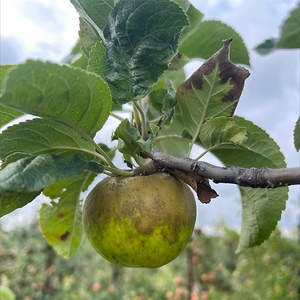


Knobby Russet Apples
Estimated Inventory, lb : 0
Description/Taste
Knobby Russet apples are a small to medium-sized varietal, averaging 6 to 7.5 centimeters in diameter, and have a conical to round shape. The apple's surface has a bright green base hue, often masked by an unusual layer of russet. The grey-black to brown russet creates raised bumps, warts, ribbing, and protrusions, giving the fruits an asymmetrical, irregular appearance with a rough, sandpaper-like texture. The surface is also enveloped in red-orange blush spots and raised lenticels. Underneath the mottled skin, the flesh is ivory to pale yellow, fine-grained, dry, and dense, encasing a small central core filled with black-brown, oval seeds. Knobby Russet apples have a firm, chewy, and dense consistency and a complex, green apple-like flavor, consisting of a balanced, sweet-tart taste with tangy notes of citrus and spice.
Seasons/Availability
Knobby Russet apples are available in the mid-fall through the late winter.
Current Facts
Knobby Russet apples, botanically classified as Malus domestica, are a rare English variety belonging to the Rosaceae family. The odd-looking fruits were discovered in the early 19th century and were initially favored for their extended storage capabilities, as many homes during this time did not have cold storage to preserve fresh fruits. Knobby Russet apples were grown as a garden variety for many years but were never commercially cultivated due to their irregular appearance. The variety almost went extinct in the mid-20th century due to increased production of newer, more aesthetically pleasing apples, but the heirloom variety was saved by apple enthusiasts as a specialty cultivar. Knobby Russet apples are also known as Knobbed Russet apples, Winter Russet apples, and Winter apples, and the fruit's outward appearance is said to be a stark contrast to its complex, pleasant taste and fine-grained texture, primarily consumed fresh or pressed for cider.
Nutritional Value
Knobby Russet apples are a good source of vitamin C to strengthen the immune system while reducing inflammation and are a source of fiber to regulate the digestive tract. The apples also contain small amounts of calcium to build strong bones and teeth, potassium to balance fluid levels within the body, and other nutrients, including phosphorous, iron, and vitamin A.
Applications
Knobby Russet apples have a sweet, tart, and tangy taste suited for fresh preparations. The apple's complex flavor is showcased when consumed straight, out-of-hand, and it is important to note that the russeted skin is edible despite its unusual consistency. One of the unique characteristics of the variety is the flesh does not brown quickly, allowing it to be sliced and eaten as a snack, chopped and tossed into salads, or quartered and displayed on fruit platters. Knobby Russet apples were also traditid for cider making. The apple’s sweet-tart juice blends well with other apple varieties creating a multifaceted flavor profile. In Sherborn, Massachusetts, Stormalong Ciders has developed a modern cider sampler pack made from rare heirloom varti. ob Rset apples are featured in their ashmead’s kernel cider, a small batch cider, and the apples are grown through small farms in New England. Beyond fresh preparations and ciders, Knobby Russet apples can also be cooked into applesauce and used as a filler variety in some baked goods such as pies or tarts. Knobby Russet apples pair well with sharp cheeses such as cheddar, blue, and asiago, herbs such as parsley, rosemary, and tarragon, spices including cinnamon, nutmeg, and cloves, vanilla, and chocolate. Whole, unwashed Knobby Russet apples will keep for 1 to 3 months when stored lightly wrapped in plastic in the crisper drawer of the refrigerator.
Ethnic/Cultural Info
Knobby Russet apples are featured in the National Collection of Sussex Apples, a grouping of heirloom apples grown through select orchards in Stanmer Park, England. The collection was established in the early 21st century, managed by the Brighton Permaculture Trust, and was created to preserve and rediscover diverse apple varieties growing in the United Kingdom. The collection features over thirty different cultivars, including Knobby Russets, and is viewed as a "living library" used to educate apple enthusiasts on the importance of heirloom apple varieties. Many researchers, horticulturalists, and historians also use the collection to study the history of apples to improve future breeding practices to create new cultivars.
Geography/History
Knobby Russet apples were first discovered in Sussex, England, in 1819. The parentage of the variety is unknown, but the cultivar was first documented by the London Horticultural Society in 1820 when they were donated by a man named Haslar Capron from Midhurst, Sussex. Once introduced to growers, the variety was favored in the 19th century for its extended storage capabilities, but the russet apples quickly fell out of favor when new varieties with improved appearances arrived on the market. Today Knobby Russet apples are considered rare and are only grown through a small number of specialty farms. The apples can still be seen through orchards in Stanmer Park in Brighton, Sussex, and they are also found in the New England area of the United States and in Vancouver, Canada. The Knobby Russet apples featured in the photograph above were sourced from the National Fruit Collection at Brogdale Farm in Faversham, Kent.
Recipe Ideas
Recipes that include Knobby Russet Apples. One
| Chatelaine |
|
Tarragon, Grilled Fennel and Apple Salad |
| Woman's Day |
|
Apple, Sweet Potato, and Rosemary Flatbread |










